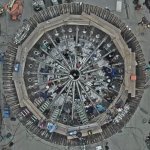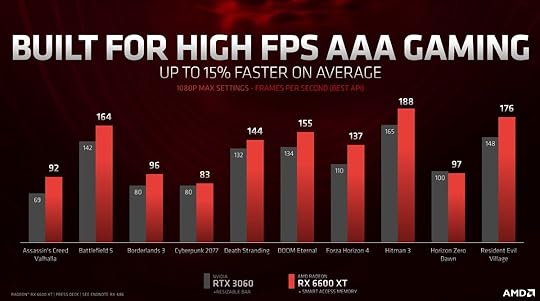Dominique Luchart's Blog, page 553
July 30, 2021
Tesla agrees to pay $1.5 million to settle battery throttling lawsuit, Andrew J. Hawkins

Tesla agreed to pay $1.5 million to settle a lawsuit alleging the company used a software update to reduce the maximum battery voltage for some of its Model S sedans, Reuters reports.
The software update, which was released in 2019, resulted in slower charging speed and diminished range for around 1,743 vehicles, the plaintiffs alleged. As a result of the settlement, Tesla agreed to pay $625 to each of the affected vehicle owners.
“This amount is many times the prorated value of the temporarily reduced maximum voltage, and thus represents an excellent and efficient result for the Settlement Class,” the court document reads. “In return, the Settlement Class will release claims related to the software updates that imposed and then restored the batteries’ maximum voltage.”
Lawyers for the owners said they conducted an investigation that found that “voltage limitation was temporary, with a 10% reduction lasting about 3 months, and a smaller 7% reduction lasting another 7 months before the corrective update was released in March 2020. Following that second update, the vehicles’ voltage showed steady restoration over time.”
It’s not immediately clear how the plaintiffs will receive their payment from Tesla. A US district court judge will convene a hearing on the proposed settlement on December 9th. A spokesperson did not respond to a request for comment; Tesla dissolved its PR department in 2019.
This isn’t the first time Tesla has been forced to pay its customers for throttling their vehicle batteries. Last May, the company was ordered to pay 136,000 kroner ($16,000) each to thousands of customers in Norway for slowing down charging speeds.
The post Tesla agrees to pay $1.5 million to settle battery throttling lawsuit, Andrew J. Hawkins appeared first on NEWDAWN Blog.
Here’s why Apple says it hates leaks, Jon Porter

Apple is a notoriously secretive company, and a cease and desist letter recently acquired by Motherboard sheds new light on exactly why, arguing that leaks harm accessory makers, consumers, and Apple itself.
The C&D order reportedly sent to a Chinese citizen by Apple’s lawyers in China, says that leaks about Apple’s iPhone dimensions could mislead case manufacturers, who might make accessories that are incompatible with the final product. As Apple puts it, “third-party accessory manufacturers may develop and sell mobile phone cases and other accessories that are not actually compatible with the unreleased products.” Motherboard notes that the market for Apple accessories is estimated to be worth almost $20 billion worldwide.
Apple also says that leaked info prevents the company from being able to surprise and delight consumers at launch events. “Apple has made every effort to take strict measures to maintain confidentiality for any information about Apple’s products before their official release to ensure that every time Apple releases a new product, it can surprise the public,” the letter reads. “The secret of Apple’s latest technological innovation is an important part of the company DNA.”
“Such situations harm the interests of consumers and Apple. Therefore, it is obvious that when the unpublished information about the design and performance of Apple’s products is kept confidential, it has actual and potential commercial value,” Apple’s letter reads.
The letter was sent as part of what appears to be a crackdown on the sale of prototypes of unannounced Apple products on social media. These devices are allegedly stolen by factory employees and sold to anyone that could benefit, often resulting in information about the products being made public far in advance of their official announcements.
Motherboard reports that the cease and desist letter it obtained was dated June 18th. It’s unclear how many individuals were sent similar letters, but it notes that the month coincides with the Twitter account of a seller, who went by the name “Mr. White,” disappearing from the platform. Also in June, a leaker known as “Kang” revealed on Weibo that they’d received a notice from the company, and indicated that they’d stop posting about upcoming devices.
Beyond what Apple outlines in its letter, there are a host of reasons why companies are widely understood to not want their unannounced plans to be made public. The release of confidential product information might allow competitors to start to develop copycat devices ahead of time. And hearing that an upgraded device is on the way could make people less likely to buy an existing model, per the so-called “Osborne effect.”
The post Here’s why Apple says it hates leaks, Jon Porter appeared first on NEWDAWN Blog.
Elon Musk shows off wild plumbing for 29-engine Super Heavy booster (photo), ,

SpaceX’s Super Heavy booster is a complicated beast.
On Thursday (July 29), SpaceX chief Elon Musk gave us an inside look at the engine section of a Super Heavy that’s coming together at the company’s South Texas site, near the Gulf Coast village of Boca Chica.
There is a lot of plumbing involved.
Related: SpaceX’s Starship and Super Heavy rocket in pictures
See more
“Completing feed system for 29 Raptor rocket engines on Super Heavy Booster,” Musk wrote via Twitter Thursday, where he posted a photo showing metal tubes radiating outward from the engine section’s core like the spokes on a bicycle wheel.
“And that’s just the primary fuel lines! The maze of secondary plumbing & wiring is our greatest concern,” he added in another tweet on Thursday.
Super Heavy is the giant first stage of Starship, the fully reusable transportation system that SpaceX is developing to take people and cargo to the moon, Mars and beyond. The upper stage is a 165-foot-tall (50 meters) spacecraft called Starship.
Both of these elements will be powered by SpaceX’s next-generation Raptor engine, which runs on liquid methane and liquid oxygen. Starship will sport six Raptors and Super Heavy will have around 30, as Musk noted in his Twitter post.
Multiple Starship prototypes have taken to the South Texas skies already. In May, for example, a three-engine vehicle known as SN15 aced a test flight that took it to a maximum altitude of 6.2 miles (10 kilometers).
No Super Heavy has lifted off yet, but SpaceX aims to change that soon. The company is gearing up for the first-ever Starship orbital test flight, which could take place in the next few months.
On that flight, a Super Heavy-Starship combo will lift off from South Texas. If all goes according to plan, the booster will splash down in the Gulf of Mexico, about 20 miles (32 km) offshore from Boca Chica. The Starship upper stage, meanwhile, will power itself to orbit and eventually come down for an ocean landing of its own near the Hawaiian island of Kauai.
We should expect additional test flights in relatively quick succession after that. Musk tends to set aggressive timelines, and his Starship plans are no exception; he has said the system could be fully up and running by 2023 if development and testing continue to go well.
Mike Wall is the author of “ Out There ” (Grand Central Publishing, 2018; illustrated by Karl Tate), a book about the search for alien life. Follow him on Twitter @michaeldwall. Follow us on Twitter @Spacedotcom or Facebook.
Join our Space Forums to keep talking space on the latest missions, night sky and more! And if you have a news tip, correction or comment, let us know at: community@space.com.
The post Elon Musk shows off wild plumbing for 29-engine Super Heavy booster (photo), , appeared first on NEWDAWN Blog.
Why does the Milky Way have spiral arms? New Gaia data are helping solve the puzzle, ,

New data from the star-mapping Gaia satellite are helping scientists unlock the mystery of our Milky Way galaxy’s spiral arms.
Recently published studies exploring the Early Data Release 3 (EDR3), a batch of observations made available to the scientific community last December, reveal the spiral structure of our galaxy with a greater precision and detail than was possible before.
Since the 1950s, astronomers have known that our galaxy, the Milky Way, looks like a spiral, with several dense streams of stars and dust emanating from the galactic center, winding through the galactic disc and dissolving around its edges. However, scientists have struggled to understand how many of these streams there are and what created them.
“The problem with our galaxy is that we are inside its disc and therefore it’s very difficult to understand the structure as a whole,” Eleonora Zari, a scientist at the Max Planck Institute for Astronomy in Heidelberg, Germany, and author of one of the new papers, told Space.com. “It’s like being in a forest and looking around. At some point, the trees are in front of each other. Plus the forest is a bit foggy, so you really can’t see what the whole forest looks like.”
Related: See a virtual Milky Way map from Europe’s Gaia spacecraft
The European Space Agency’s (ESA) Gaia mission has been mapping the Milky Way since 2014, measuring the precise positions and distances from Earth of nearly two billion stars. The first two batches of data acquired by the spacecraft, which were released to the scientific community in 2016 and 2018, have revolutionized the study of our galaxy. In addition to the fixed positions, the spacecraft also measures how fast stars move in three-dimensional space, allowing astronomers to model the evolution of the Milky Way in the past as well as into the future.
The latest data release, EDR3, improves the accuracy of the previous data sets. And it’s this precision that is enabling astronomers to disentangle the spiral arms from the rest of the stars in the galactic disc with better precision.
Where are the arms?“We derive the distance of the stars from a measure called the parallax,” Zari said. “And this parallax measurement is 20% better with the latest release. That means that stars that previously we may have seen as part of the same structure now clearly belong to different structures.”
Parallax is a star’s apparent movement against the background of more distant stars as Earth revolves around the sun. By measuring the change in the angle between the star and Earth from two opposite points in the planet’s orbit, astronomers can calculate the distance of the star using simple trigonometry.
In one new paper, Zari and her colleagues looked at concentrations of hot bright blue stars, called the OBA-type stars, in the Milky Way’s disc. In areas where they could see a higher-than-average concentration of these stars, they could assume the existence of a spiral arm. They then compared their analysis with previously developed models of the galaxy.
“The position of the spiral arms is different and also the strength of the spiral arms, how bright they are, is different,” Zari said.
The Milky Way is known to have two main spiral arms, the Perseus arm and the Scutum-Centaurus arm. Our galaxy also possesses two less pronounced arms, or spurs, called the Sagittarius and the Local Arm (which passes close to the sun).
But in Zari’s study, the difference between the arms doesn’t seem so obvious.
“The Perseus arm seems less bright, and instead the Local arm is more prominent,” she said. “Aso the other two arms — Sagittarius and Scutum Centaurus — at least in my study, they seem to have about the same brightness.”
[image error]
Scientists can predict the future motions of stars in the Milky Way from Gaia data. (Image credit: ESA)Zari’s colleague Eloisa Poggio looked at concentrations of 600,000 young stars to determine the precise position of the spiral arms. Young stars are especially valuable when studying the spiral arms, Poggio explained, because spiral arms, with their dense concentration of dust and gas, are believed to be where the majority of stars form.
“We calculated, for each position in the disc, whether that region was more or less populated with respect to the average,” Poggio told Space.com. “Using that approach, we were able to construct a map of the spiral arms in the region that Gaia maps, that is about 16,000 light-years around the sun.”
When the researchers compared their galaxy map to previous models, they found that the Perseus arm, one of the two dominant arms, lies further away from the center of the galaxy in the studied region. The short Local arm appeared much longer than the previous models expected.
[image error]
Poggio used Gaia data to map the regions of the Milky Way with higher concentrations of young stars. (Image credit: Poggio et al)How do the arms form?Astronomers are also still speculating about the origin of those arms and their longevity. Some earlier theories proposed that the shape of the arms is somehow fixed and spins around the galactic center over a long period of time while individual stars, orbiting at their own velocities, move in and out of this shape.
This so-called density wave theory, however, is being disputed by the latest findings enabled by the Gaia mission. Many scientists now think that the spiral arms might not be fixed at all. Instead, they might form temporarily, as a result of the rotation of the galactic disc, and later dissolve and reform again in a different configuration.
To find which theory is correct, Alfred Castro, of the University of Leiden, in the Netherlands, looked at so-called open clusters, groups of thousands of young stars born from the same cloud of gas and dust. Due to their young age, these stars are still close to their birth place, that is within the spiral arms. If the newer theories were correct, the amount of younger open clusters in the spiral arms would be higher than the amount of older open clusters, Castro speculated. And that’s exactly what the data showed.
“I saw in the data that the spiral structure appears to contain the younger population of stars but disappears if you look at the older stars,” Castro told Space.com. “We see that the rotation rate of the shape is more or less similar to the rotation rate of the stars and varies with the radius to the galactic center. The shape and the stars can’t be decoupled, and that means we don’t have a global shape, which would be the spiral arms, and then the stars moving in and out of them as the density wave theory suggests.”
According to Castro’s analysis, the spiral arms may exist for about 80 to 100 million years, a small fraction of time in the 13-billion-year life of our galaxy.
What gave the Milky Way the spiral arms?In the future, Poggio hopes, scientists might be able to find out why those spiral arms in the Milky Way exist in the first place. While some theories expect this swirl of stellar streams may have been born after another, smaller galaxy crashed into the Milky Way, others believe it came to existence naturally as a result of the rotation of the galactic disc.
“We expect that we would see different signatures in the motion of the stars if the spiral arms were caused by an external impact,” Poggio said. “Future Gaia data releases will give us more information about the motion of stars in a greater portion of the galactic disc, and we hope we might be able to find something there.”
The next batch of Gaia data, the full Data Release 3, is expected to be made available to scientists worldwide in about mid-2022. Gaia, one of the most productive missions in history (measured by the number of scientific papers it produces), will continue scanning the sky until 2025. The vast catalogues of stellar positions, motions and velocities it creates will keep astronomers busy for decades to come.
The papers by Poggio, Castro and Zari were published in the journal Astronomy and Astrophysics in July.
Follow Tereza Pultarova on Twitter @TerezaPultarova. Follow us on Twitter @Spacedotcom and on Facebook.
The post Why does the Milky Way have spiral arms? New Gaia data are helping solve the puzzle, , appeared first on NEWDAWN Blog.
These 10 super extreme exoplanets are out of this world, ,

It’s almost hard to believe that until the early years of the 1990s, astronomers had yet to discover a planet outside the solar system.
Even though scientists were certain that other stars orbited other stars, there was little evidence of other planetary systems until the discovery of two extrasolar planets — or exoplanets — orbiting the pulsar PSR 1257+12 in 1992 by Aleksander Wolszczan and Dale Frail, as logged in the journal Nature.
This initial discovery was soon followed by the observation of 51 Pegasi b — the first exoplanet discovered around a sun-like star — in 1995, for which astronomers Michel Mayor and Didier Queloz were awarded the 2019 Nobel Prize in Physics.
Related: 10 exoplanets that could host alien life
All About Space
[image error]
(Image credit: Future)This article is brought to you by All About Space .
All About Space magazine takes you on an awe-inspiring journey through our solar system and beyond, from the amazing technology and spacecraft that enables humanity to venture into orbit, to the complexities of space science.
Since 1995, our exoplanet catalog has rapidly expanded. We have now confirmed over 4,000 worlds outside our solar system, with a further 7,000 or so suspects waiting to be classified, according to NASA.
As our observation methods improve, this discovery process has only really just begun. And later this year, the James Webb Space Telescope (JWST) will launch, with part of its mission dedicated to search for exoplanets.
A surprising factor has started to present itself as we learn more about worlds outside the solar system; the universe is weird. Really weird. From worlds that rain iron and glass to diamond worlds and planets that have escaped the grip of their parent stars, our burgeoning exoplanet catalog demonstrates that our own solar system is reassuringly boring.
WASP-76b: The exoplanet that rains molten iron[image error]
The nightside of WASP-76 b may be cooler, but it’s no more welcoming. This illustration shows the iron rains that bombard the surface of the planet. (Image credit: ESO/M. Kornmesser)Spotted in 2013 and further investigated by the ESPRESSO instrument on the Very Large Telescope in 2020, WASP-76b is a planet that is tidal-locked to its parent star BD+01 316. This means that one side of the planet permanently faces the star causing scorchingly hot temperatures of around 4,532 degrees F (2,500 degrees C) — hot enough to vaporize iron.
The star-facing side of WASP-76b is roasted by radiation that is thousands of times more intense than that Earth receives from the sun, while the side that faces away from the F-type star experiences perpetual night. Yet even though the “dayside” of the planet experiences hellish temperatures, that doesn’t mean that conditions on the “nightside” are a walk in the park.
The side of WASP-76b that faces away from the planet’s parent star is cooler by at least 1,832 degrees F (1,000 degrees C), but this means that when iron vapor is carried across the hemisphere by powerful winds, they are cooled, forming liquid droplets. These droplets of molten iron then fall, bombarding the cooler side of the planet.
The key clue that allowed astronomers to discover the presence of these iron rains came when the ESPRESSO instrument was used to investigate WASP-76b’s atmosphere, and no traces of the element were found on one side of the world. WASP-76b isn’t the only planet that experiences nightmare rains of this nature. As is often the case with exoplanets, further discoveries don’t just up the ante, they make things a whole lot stranger.
HD 189733 b: Showers of molten glass[image error]
An artist’s conception of HD 189733 b, a beautiful giant marble that gives no hint of its deadly weather conditions. (Image credit: NASA, ESA, M. Kornmesser)From space, HD 189733 b may appear to be a beautiful and tranquil world, resembling a giant glassy blue marble. With exoplanets, though, appearances can be deceptive, and this definitely the case for this gas-giant planet that completes an orbit of its star in just 2.2 days.
In fact, its beautiful blue hue arises from its deadly weather, particularly the molten glass rains that pelt the planet’s surface. Yet, this isn’t the extent of the planet’s almost maniacal weather conditions. The exoplanet — discovered in 2005 by both NASA‘s Chandra X-ray Observatory and ESA’s XMM Newton’s X-ray telescopes — also experiences winds of around 5,600 miles (9,000 kilometers) per hour. These supersonic winds cause the exoplanet’s glass rains to arc sideways towards the ground rather than just falling, also picking up silicate particles, turning them into microscopic projectiles.
HD 189733 b isn’t just interesting to astronomers because of its unusual and hazardous weather, though. The giant exoplanet has been observed to possess an atmosphere that is much larger than scientists would expect for such a world, according to NASA. This extended atmosphere works to catch more of the considerable radiation HD 189733 b receives from its parent stars thanks to its perilously close orbit, meaning the gas giant experiences temperatures as high as 1,700 degrees F (930 degrees C).
The fact that the exoplanet’s atmosphere is capturing so much intense radiation from the stars of the HD 189733 binary system means that it is rapidly being stripped away to space. All may not be lost, however, as another extreme exoplanet demonstrates that sometimes depleted atmospheres get a second chance.
Gliese 1132b: The planet that grew a second atmosphere[image error]
An artist’s impression of Gliese 1132 b an exoplanet that was stripped of an atmosphere and then uniquely, grew another. (Image credit: NASA, ESA, and R. Hurt (IPAC/Caltech))Gliese 1132 b is similar to Earth in a striking number of ways. Its radius is only slightly larger, as is its mass. Even its age — 4.5 billion years old — is similar to that of our planet. But this world does have one striking difference, it orbits much closer to its red dwarf parent star, completing an orbit in just 1.6 Earth days. This proximity results in Gliese 1132 b experiencing a much higher surface temperature than our planet at 278 degrees F (137 degrees C), with the intense radiation stripping the exoplanet’s atmosphere.
Yet, astronomers have recently discovered that something extraordinary is happening on Gliese 1132 b. The gravitational influence of its star — 20% larger than the sun — creates intense tidal forces that squeeze and stretch the planet. This “flexing” gives rise to violent volcanic activity and causes gases to rush to the world’s surface.
These gases are building the world a second atmosphere, according to NASA. Whilst this is exciting in itself being the first time astronomers have ever spotted anything like this, the “regrown” atmosphere due to its origin also provides astrogeologists with a unique opportunity to study the interior chemical composition of an exoplanet by proxy.
Kepler-10b: In a galaxy far, far away…[image error]
Kepler 10 b’s lava-ridden surface has drawn comparisons with the planet Mustafar in the Star Wars Franchise. Definitely not the best place for a lightsaber battle. (Image credit: NASA/Kepler Mission/Dana Berry)Kepler-10b orbits close to its host star — similar to the sun — at a distance that is a twentieth of the orbit of Mercury. This results in an orbit less than an Earth-day and a surface temperature hotter than 2,372 degrees F (1,300 degrees C).
Because Kepler-10 b — discovered in 2011 by the Kepler telescope — is tidally locked to its star it also creates molten droplets of iron and silicates. The planet’s surface is likely covered with lava much hotter than that found on Earth. Because the harsh radiation from its host star has stripped away its atmosphere, these droplets on Kepler-10b won’t fall on the nightside of the planet, are instead blown clear of its surface by stellar winds, giving it a fiery tail.
Kepler-10 b isn’t the only lava world discovered by the Kepler telescope. In 2013, the space telescope also found the exoplanet Kepler-78b — 40 times closer to its host star than Mercury–that completes a full orbit in a matter of hours. The result is an Earth-like world dominated by lava which has been described by astronomer Dimitar Sasselov as “an abomination.”
Given their broiling lava surfaces, it’s little wonder that these exoplanets have been compared to Mustafar, the planet in the Star Wars franchise that hosts a lightsaber duel between Obi-Wan Kenobi and Anakin Skywalker. The lava of that fictional world results in hideous injuries to the young Jedi that force him to wear the iconic black armor and breathing apparatus of Darth Vader. Perhaps when considering a world to hold a duel to the death, somewhere that offers a cooler climate may be advisable. Fortunately, some exoplanets offer radically divergent conditions.
Upsilon Andromeda b: A world of fire and ice[image error]
Upsilon Andromeda b is an exoplanet of varying extremes of temperature. Its dayside which permanently faces its parent star experiences hellishly high temperatures, whilst its nightside is below freezing. (Image credit: NASA/JPL-Caltech)Upsilon Andromeda b is another exoplanet that is probably tidally locked to its host star, completing an orbit in just under five days. What makes this planet — which was previously known as Saffar — an extreme world is the radical difference in temperature between its dayside and nightside.
Whilst the dayside experiences temperatures as high as 2,912 degrees F (1,600 degrees C), the nightside is considerably cooler, reaching temperatures as low as minus 4 degrees F (minus 20 degrees C). This means that passing the hemisphere of this world could be considered equivalent to jumping into a volcano.
While this is by no means the only tidally locked Hot Jupiter, the others we have discovered don’t seem to feature such radical disparities in temperature between their star-facing and star-ignoring sides. The reason this exoplanet experiences such a radical difference in temperature could be due to the tremendous size of its parent star Upsilon Andromedae A, or the fact that the star possesses a hot spot almost directly “overhead” this exoplanet, according to NASA.
By now, you might well be getting the impression that all exoplanets are hot, violent worlds that exist close to their parent stars. The fact is, the closer a planet’s orbit brings it to its host star, the easier it is to spot. This means the exoplanet catalog is bursting with larger worlds that have tight orbits. There are some notable exceptions, however.
HR 5183 b: The whiplash planet[image error]
Animated graphic shows the bizarre looping orbit of the alien planet HR 5183 b as compared to the orbits of planets in our own solar system. (Image credit: W. M. Keck Observatory/Adam Makarenko)In terms of exoplanet discoveries, HR 5183 b — a “Super-Jupiter” three times the mass of the solar system’s largest planet — is unique, as its orbit is highly eccentric, both literally and figuratively. While most planets trace out a mostly circular orbit, this gas giant traces out an egg-shaped orbit around its parent star HR 5183, according to astronomers at Caltech.
Astronomers discovered the exoplanet by the tiny wobble its gravity causes upon its parent star, which in turn causes a dip in brightness. The process took a staggering 20 years of observations with three telescopes, including Hawaii’s W. M. Keck Observatory. Despite this long period of observation, we are yet to see the world complete a full orbit, with researchers estimating that this could take between 45 to 100 Earth years — probably 74 years.
If HR 5183 b was to follow its orbit in the solar system, it would pass closer to the sun than Jupiter, and then move to the outer edges of our planetary system swinging past Neptune. Highly eccentric orbits such as this have been observed before, but normally by planets and other objects that are much closer to their host stars.
If HR 5183 b’s loose association with its parent star is something of a surprise, some worlds have gone to even further extremes, disassociating with their parent stars entirely to wander the universe alone.
OGLE-2016-BLG-1928: Going rogue[image error]
An artist’s impression of a microlensing event that could help astronomers spot rogue exoplanets like OGLE-2016-BLG-1928. (Image credit: Jan Skowron / Astronomical Observatory, University of Warsaw)Astronomers believe that the Milky Way could be teeming with cosmic orphans — exoplanets that have broken free of their parent stars to wander their galaxies alone. These planets are believed to form in traditional ways around stars, but are later flung away by gravitational interactions with other planets.
Because exoplanets are usually spotted through the effect they have on their host stars, this makes these homeless planets almost impossible to spot. This is especially true when they are Earth-sized rocky planets. That’s what makes the discovery of the rogue exoplanet OGLE-2016-BLG-1928 as it wanders the Milky Way so special. While it isn’t the first rogue planet to be discovered, it is the smallest, with other examples much similar in size to Jupiter.
The rogue terrestrial world was spotted in late 2020 using a technique called gravitational microlensing, the deflection and focusing of light from a distant star as an object passes in front of it. The duration of the change in the light profile of these distant sources increases with the mass of the intervening object. The disturbance caused by OGLE-2016-BLG-1928 lasted just 41 minutes, thus telling astronomers that it was the smallest rogue spotted using this method thus far. OGLE-2016-BLG-1928 is remarkable because of its lack of association with a planetary system, but for other exoplanets, it’s this relationship that makes for something special.
The TOI-178 system: A system of harmony and chaos[image error]
Artist’s impression of the TOI-178 system. (Image credit: ESA)At first glance, the planetary system TOI-178 may look like any other set of worlds. But, a closer and more prolonged observation reveals that at least five of this system’s six worlds are locked in a rhythmic dance with each other.
The five outer planets exist in an 18:9:6:4:3 resonance. This means the first exoplanet in the chain — the second closest to the star overall — completes 18 orbits as the second in the chain completes nine, the third completes six, and the fourth completes 4, and the fifth — the sixth planet overall–completes three orbits. This means that the planets align at regular intervals as they orbit their orange dwarf host star.
This complex chain of resonance likely indicates a planetary system that has remained undisturbed by gravitation interactions or collisions with other systems since its formation. That means the system could be crucial in the study of how planetary systems form and evolve.
Yet, where we find order in the cosmos, there is often also chaos. The compositions of the planets that make up the TOI-178 system don’t display the harmony exhibited by their motion. Next to a dense terrestrial Earth-like world is a “puffed-out” low-density planet, followed by an exoplanet with a density similar to that of Neptune.
55 Cancri e: The universe’s most valuable exoplanet[image error]
Artist’s impression of 55 Cancri e. The molten hot super-Earth 55 Cancri e could be the most valuable object in the universe if theories that it is composed of diamond are correct. (Image credit: ESA/Hubble, M. Kornmesser)Another star that orbits close to its host stars, taking under 18 hours to complete an orbit, 55 Cancri e is also inhospitably hot–reaching temperatures as high as 4,172 degrees F (2,300 degrees C). But what really sets this world apart is its composition, which makes the exoplanet, formally known as Janssen, perhaps the most conventionally valuable object in the universe.
The fact that 55 Cancri e is twice the size of Earth, but has almost 9 times the mass, led astronomers to propose that this Super-Earth could be composed of high pressurized carbon in the form of graphite and diamond mixed with some iron and other elements, according to NASA.
The estimated value of 55 Cancri e is estimated to be 384 quadrillion times more than Earth’s entire Gross Domestic Product (GDP), which was valued at 70 USD in 2011. Some astrophysicists suggest that such diamond worlds could form fairly regularly when protoplanetary dust clouds that contained high ratios of carbon collapse to form planets.
The idea that 55 Cancri e is made of diamond has been challenged since the exoplanet was first discovered in 2004, moving in and out of favor, proving diamonds may not be forever. Yet despite all these extreme worlds, the most extraordinary exoplanets may still be out there for us to discover, and they may exist in systems of the likes that we have never encountered before.
Blanets: Black holes’ extreme exoplanets[image error]
Artist’s impression of a black hole seen from an orbiting planet. (Image credit: MARK GARLICK/SCIENCE PHOTO LIBRARY)The most extreme exoplanets may not form around stars at all, but instead could orbit supermassive black holes. Planets form from the gravitational collapse of over-dense areas of protoplanetary clouds of gas of dust and supermassive black holes at the heart of active galactic nuclei (AGN) sit at the center of massive churning discs of such materials.
Currently, there is no evidence that such black-hole-orbiting planets — or “blanets” — actually exist, but recent research modeling the dynamics of these discs of gas and dust does suggest that under certain conditions planet formation should occur in such regions. Should such processes occur, blanets would form much further out from supermassive black holes than most planets do from their parent star. So distant in fact, that it could take a million years for such a world to complete an orbit!
Radiation from the AGN could help provide a constant supply of fresh material for blanet formation, with the result of this could be runaway formation, meaning blanets could reach sizes much more titanic than “regular” exoplanets. Blanets would be less likely to share other similarities to Earth or Jupiter, meaning whole new classes of astronomical objects beyond gas giants and terrestrial worlds to investigate.
With the nearest AGN existing beyond the limits of current exoplanet investigations, the discovery of blanets may have to wait. Until then, astronomy will provide a cavalcade of exoplanet discoveries that challenge our growing understanding of the universe and redefine our place within it.
This article was adapted from a previous version published in All About Space magazine, a Future Ltd. publication.
The post These 10 super extreme exoplanets are out of this world, , appeared first on NEWDAWN Blog.
Ariane 5 rocket launching 2 communications satellites today: Watch it live, ,

Europe’s powerful Ariane 5 rocket will fly for the first time in nearly a year today (July 30), and you can watch the liftoff live.
An Ariane 5 topped with two communications satellites is scheduled to launch from Europe’s Spaceport in Kourou, French Guiana, this evening during a 90-minute window that opens at 5 p.m. EDT (2100 GMT). You can watch the action live here at Space.com, courtesy of Ariane 5 operator Arianespace, or directly via the French company.
One satellite going up today is Star One D2, which will be operated by Brazilian telecom company Embratel. The spacecraft will allow Embratel “to expand broadband coverage to new regions in Central and South America, provide internet access to underserved populations and add an updated X-band payload for government use over the Atlantic region,” Arianespace representatives wrote in a mission description.
The other satellite aboard the Ariane 5 is Eutelsat Quantum, which was developed jointly by French company Eutelsat, Airbus Defence and Space and the European Space Agency. Eutelsat will operate the satellite, which features an active antenna that’s “a first for the European commercial telecommunications industry,” Arianespace representatives wrote in the mission description.
The Ariane 5 last flew in August 2020. On two separate launches that year, the rocket experienced some problems with the system that enables separation of its payload fairing, the nose cone that protects payloads during launch. Both of those missions were successful, but Arianespace took the Ariane 5 out of action to troubleshoot the issue, as Space News reported.
NASA will doubtless be watching this evening’s launch — and another Ariane 5 liftoff scheduled for September — with great interest. One of the agency’s most highly anticipated missions, the $9.8 billion James Webb Space Telescope, will launch on an Ariane 5 from Kourou this fall.
Mike Wall is the author of “ Out There ” (Grand Central Publishing, 2018; illustrated by Karl Tate), a book about the search for alien life. Follow him on Twitter @michaeldwall. Follow us on Twitter @Spacedotcom or Facebook.
Join our Space Forums to keep talking space on the latest missions, night sky and more! And if you have a news tip, correction or comment, let us know at: community@space.com.
The post Ariane 5 rocket launching 2 communications satellites today: Watch it live, , appeared first on NEWDAWN Blog.
On This Day in Space! July 30, 1610: Galileo sees Saturn’s rings for the first time, ,

On July 30, 1610, the famous astronomer Galileo Galilei became the first to observe rings around the planet Saturn.
Shortly after the telescope was invented in 1608, Galileo peered out into the solar system and saw the amazing ring system. At first he didn’t actually think they were rings.
Instead, Galileo thought Saturn might have planetary “love handles” that gave it a weird shape. He also wondered if perhaps he was looking at two very large moons on either side of the planet. It wasn’t until 1659 that another astronomer named Christiaan Huygens figured out that these weird features were actually rings.
Catch up on our entire “On This Day In Space” series on YouTube with this playlist.
[image error]
History of NASA: $22.99 at Magazines Direct
Discover the story of how and why NASA was created, its greatest triumphs, darkest days, and of the times it exceeded all possible hopes. A tale of adventure, heroism and resourcefulness, learn of the space agency’s greatest achievements and how — over six decades — the organization has consistently and tirelessly devoted itself to its founding principle: that “activities in space should be devoted to peaceful purposes for the benefit of all humankind”. View Deal
Still not enough space? Don’t forget to check out our Space Image of the Day, and on the weekends our Best Space Photos and Top Space News Stories of the week.
Email Hanneke Weitering at hweitering@space.com or follow her @hannekescience. Follow us @Spacedotcom and on Facebook.
Join our Space Forums to keep talking space on the latest missions, night sky and more! And if you have a news tip, correction or comment, let us know at: community@space.com.
The post On This Day in Space! July 30, 1610: Galileo sees Saturn’s rings for the first time, , appeared first on NEWDAWN Blog.
Sgt. Pepper’s to get new Atmos mix because current version ‘doesn’t sound quite right’, Jon Porter

The Beatles seminal Sgt. Pepper’s Lonely Hearts Club Band is set to receive another Dolby Atmos mix, after producer Giles Martin, son of the album’s original producer George Martin, admitted that the current version “doesn’t sound quite right.” The current mix, produced by the younger Martin in 2017, was made with Dolby Atmos theaters in mind, rather than personal listening via services like Apple Music. “I’m gonna replace it,” the said the two time Grammy winner to Rolling Stone. “It’s good. But it’s not right.”
The current Atmos mix of the album was created to coincide with its 50th anniversary in 2017. At the time, it was designed to be played in Dolby Atmos cinemas at a series of live listening events. But now that it is available via streaming services like Amazon Music HD and more recently Apple Music, people are listening to it in smaller rooms or with headphones.
“Sgt. Pepper’s was, I think, the first album ever mixed in Dolby Atmos. And we did that as a theatrical presentation,” Martin explains. “So Sgt. Pepper’s is a theatrical mix that’s then being converted into a smaller medium. Therefore, it’s not quite right. I’m gonna go back to the theatrical mix and make it into what’s called near-field Dolby Atmos, as opposed to the cinema Dolby Atmos. It’s a bit bright. It’s a bit digital. But again, I’m gonna replace it, so that’s cool.”
According to Martin, the spatial mix of Sgt. Pepper’s “seems to lack a bit of bass and a little bit of weight behind it.” In comparison, the Atmos mix of Abbey Road, which was produced for its 50th anniversary in 2019 is “a much better-functioning Atmos mix because it’s much closer to the stereo mix, sonically.”
What’s particularly fascinating about Sgt. Pepper’s, is that the album was released at a time when mono recordings were the primary focus for most producers, according to NPR. George Martin reportedly spent three weeks mixing the original mono version of the album, before spending just three days on the stereo release. The album has effectively lasted through three eras of music: first mono, then stereo, and now spatial audio.
With spatial audio in its infancy, there are plenty of examples out there of well known albums that don’t sound quite right in the new format. My colleague Chris Welch outlines a few of these in his review of Apple Music’s spatial audio, where songs like “Buddy Holly” by Weezer and “What’s My Age Again?” by Blink 182 suffer from problems like muffled vocals and lifeless guitars. But hopefully these are just growing pains associated with a relatively new format, and we’ll one day look back on these tracks like we look back on early stereo recordings from the 60s.
Giles Martin’s full interview with Rolling Stone is well worth a read for the producer’s insights on the potential for spatial audio.
The post Sgt. Pepper’s to get new Atmos mix because current version ‘doesn’t sound quite right’, Jon Porter appeared first on NEWDAWN Blog.
July 29, 2021
AMD’s new Radeon RX 6600 XT offers 1080p RDNA 2 gaming for $379, Chaim Gartenberg

AMD has a new entry-level RX 6000-series GPU: the $379 RX 6600 XT, which is still based on the same RDNA 2 architecture as its beefier cousins, but it offers a more wallet-friendly price point. The new card promises the “ultimate 1080p gaming experience,” for customers who don’t necessarily need a next-gen 4K gaming setup.
At a suggested retail price of $379 (AMD isn’t selling its own version of the card), the RX 6600 XT slots at an even cheaper price point than the $479 RX 6700 XT that the company released earlier this year, which targeted 1440p gaming.
The RX 6600 XT features 32 compute units, 8GB of GDDR6 RAM, a 2359 MHz base clock, 2589 MHz boosted clock, and draws 160W of power. For comparison, the top-of-the-line RX 6900 XT 80 compute units, while the RX 6700 XT offers 40 compute units.
 The RX 6600 XT, compared to AMD’s other 6000-series GPUsImage: AMD
The RX 6600 XT, compared to AMD’s other 6000-series GPUsImage: AMDAMD’s logic here, though, is that most players don’t actually have the setup necessary for a full 4K gaming rig, which requires not only the latest and greatest in GPUs but also a processor and a display that can pump out enough pixels. The company cited research from IDC that claimed that roughly two-thirds of gaming displays sold last year were 1080p panels — but also that growth in high-refresh displays was 20 times higher than lower-refresh rate models.
The RX 6600 XT is meant to slot into those trends perfectly, promising to be able to run AAA titles like Battlefield 5 or Cyberpunk 2077 at high frame rates on maximum 1080p settings. The new card isn’t meant for someone who wants the latest and greatest GPU — it’s for customers using an outdated GPU like the aging GTX 1060 (which still accounts for almost 10 percent of all graphics cards in Steam’s hardware survey and can struggle with more recent games).
 RX 6600 XT benchmarks versus the RTX 3060.Image: AMD
RX 6600 XT benchmarks versus the RTX 3060.Image: AMDThe new RX 6600 XT also offers a big boost over AMD’s 5000-series cards, offering 1.4x or greater improvements in FPS rates compared to the RX 5600 XT and RX 5700 for titles like Assassin’s Creed Valhalla and Doom Eternal. AMD also claims that the new card outperforms Nvidia’s similarly entry-level RTX 3060 GPU, which (at least in theory) starts at $329.
AMD is also aware that supply may be an issue for the new card, commenting at a press briefing that “we’re doing our best to get supply, but the demand is unprecedented, and also the supply constraints are real, so we are working with those situations at hand.” Given the general difficulty in buying new GPUs these days, it might be best to prepare for another round of hard-to-find cards, though.
The RX 6600 XT will be available starting on August 11th from AMD’s usual slate of partners, including ASRock, Asus, Biostar, Gigabyte, MSI, PowerColor, Sapphire, XFX and Yeston, with prebuilt systems set to arrive sometime in August, too.
The post AMD’s new Radeon RX 6600 XT offers 1080p RDNA 2 gaming for $379, Chaim Gartenberg appeared first on NEWDAWN Blog.
Dish adds HBO Max and will now offer HBO and Cinemax, Catie Keck

Following a prolonged standoff between Dish Network and AT&T over licensing terms to carry HBO channels, Dish has reached an agreement with WarnerMedia to offer HBO, HBO Max, and Cinemax.
Dish TV customers nationwide will be able to access both the HBO and Cinemax networks today, though they’ll need to subscribe to HBO Max to get linear HBO. To promote the deal, Dish will run a free 10-day preview of the premium networks for existing customers right around the time the Olympics Games will be wrapping up, from August 6 to August 15. Customers don’t have to do anything to take advantage of the preview; the networks will appear automatically.
Users interested in subscribing to HBO Max can score a discounted subscription to the service’s ad-free plan at $12 per month for up to a year if they sign up before October 27th. The service normally costs $15 per month without ads, or $10 per month if you don’t mind seeing ads on non-HBO titles. Cinemax will cost an additional $10 per month and will also include the 5-Star Max and More Max channels.
Potential subscribers should keep in mind that WarnerMedia is throwing all of its 2021 slate of films on the service, where they’ll debut the same day they premiere in theaters. (However, its ad-supported tier will not include day-and-date releases like Dune, The Matrix 4, and The Suicide Squad.) Subscribing to HBO Max will also unlock HBO as well as a handful of additional premium HBO channels, including HBO Family, HBO 2, HBO Latino, and HBO Signature.
HBO East, HBO West, HBO 2, and HBO Latino can be accessed with a satellite dish, and HBO Signature, HBO Family, and HBO on-demand content will require an internet-connected Hopper or Wally receiver. HBO Max is available across connected streaming devices and on most major platforms.
The deal marks the end of a dispute over distribution terms between AT&T and Dish that’s been ongoing since 2018, but it also arrives as HBO Max — and every streamer for that matter — looks to expand its subscriber base. The launch of HBO Max and its sister networks on Dish marks “a key addition to our distribution strategy for the platform,” Scott Miller, EVP of business and legal affairs for WarnerMedia, said in a statement.
The post Dish adds HBO Max and will now offer HBO and Cinemax, Catie Keck appeared first on NEWDAWN Blog.



